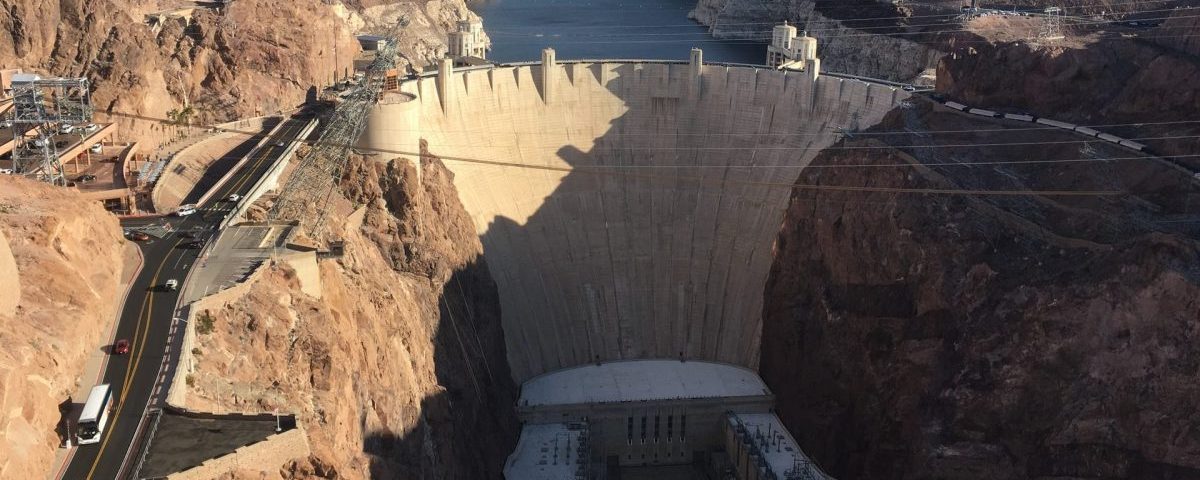
In the latest episode of our podcast Sounds Like Infrastructure we look into the story behind another Megaproject: Hoover Dam. Read on or listen on your favourite podcasting platform (Apple, Spotify, Youtube). We’ve also included links to specific parts of the episode so you can jump straight to your favourite bits.
Why Hoover Dam in Colorado River almost didn’t happen at all?
In 1922, representatives from the states of Nevada, Arizona, New Mexico, Colorado, Wyoming, California and Utah all gathered together in one room. They were there because they could all agree on one thing: That they wanted to dam the Colorado river.
What they couldn’t agree on however, were water rights. Basically how much water each state should get. While states like Nevada, Arizona and California saw the dam as an opportunity for immediate economic growth, upper states like Wyoming weren’t in a position to take immediate advantage of the dam. But they knew that if they gave up their water rights now, that this would probably slow down their economic growth in the future.
And so discussions went round and round without ever reaching an agreement. Luckily, there was one other representative at the table; the Government’s representative and Secretary of Commerce, Herbert Hoover. Hoover supervised the negotiations and knew he had to do something to break the deadlock. And after many, many meetings, the seven states finally agreed on a deal..
But the promise Hoover made to the seven states (basically a promise of limitless water) wasn’t quite the truth. (More on that at minute 17:06 of the podcast). However, that didn’t matter at the time. What was most important was getting the deal done. And so with the paperwork ironed out, the contract to build the dam was given to a company, called Six Companies (yes, Six Companies was actually one company), a consortium of smaller companies that all came together to bid on the project as one individual company, as per government rules.
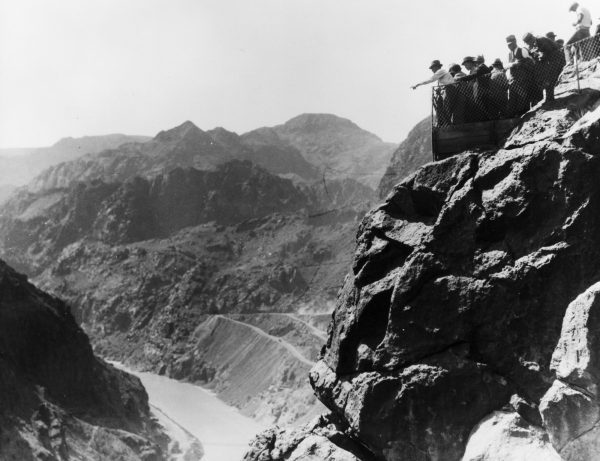 Surveyors point out a potential location for the dam in the canyon
Surveyors point out a potential location for the dam in the canyon
How did they build Hoover Dam?
Before any concrete could be poured, the diversion tunnels that would temporarily divert the course of the river had to be built. To do that, they had to drill 4 main tunnels. Two on either side of the canyon. This process was carried out through excavation and explosives. The tunnels they were excavating would be 56 feet in diameter, and were the largest tunnels ever drilled at the time.
The tunnels were so big in fact, that the team working on the project had to invent equipment on site that would allow them to drill holes in the rock face, place explosives in those holes, and then detonate the explosives to move forward. The invention they came up with was called the Jumbo. Basically a moveable scaffold that would hold dozens of drills that would then be operated by several dozen men and could be wheeled in and out between detonations. (Min 6.42)
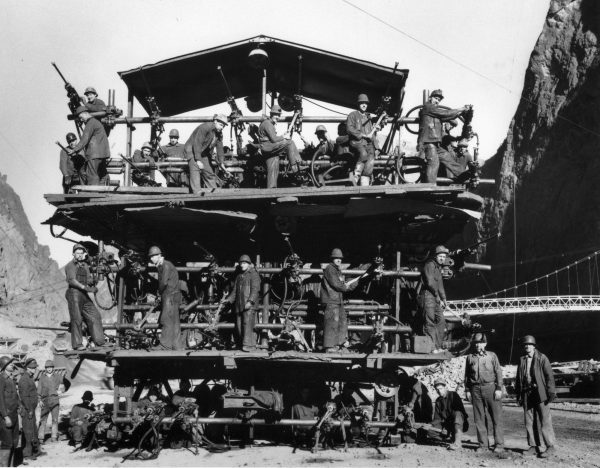 Men aboard the ‘Jumbo’ which was used for drilling the tunnels of Hoover Dam
Men aboard the ‘Jumbo’ which was used for drilling the tunnels of Hoover Dam
There are 3.36 million cubic metres of concrete in Hoover Dam. That’s more concrete poured in one place than had been used in any concrete dam built in the United States up until that point… all put together. And using this much concrete required a lot of planning. The construction company built two concrete factories on site to produce the concrete that was needed. But engineers also had to keep something else in mind.
When concrete cures, basically when it dries out, it creates heat. So as they poured the concrete, workers also laid a network of hollow pipes that were connected to refrigeration stations. These stations would produce cold water that was then pumped into the pipes to help speed up the curing process (more about that at min 12:22). If this hadn’t been done, Hoover Dam would probably still be cooling today.
Was construction on Hoover Dam dangerous?
To put it simply, yes it was. At a time when it wasn’t unusual for injury or even death on construction sites, the Hoover Dam project had a particularly bad rep (the official number of deaths is 96, though that number is thought to be higher due to some dodgy data collection. (More on that at minute 8:25 of the podcast).
First there were the explosives they used to build the tunnels. They would send rocks flying dangerously through the air. But they could explode early, sending men flying across those same tunnels. Sometimes the explosives wouldn’t explode at all, and men would return to the rock face, begin drilling and accidentally hit a piece of unexploded dynamite.
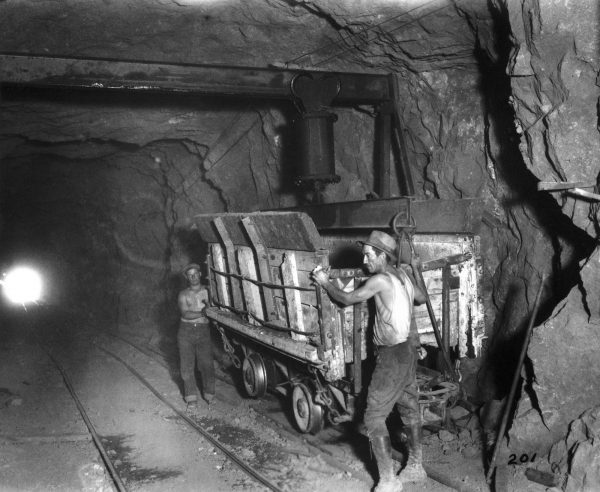 Men working on the diversion tunnels at Hoover Dam
Men working on the diversion tunnels at Hoover Dam
Outside the tunnels were another group of workers known as the High Scalers, whose job was to clear the canyon walls of loose rock. They would be attached to a rope that was secured at the top of the canyon and then swing across it, clearing the loose rock so it wouldn’t fall on men or machinery below.
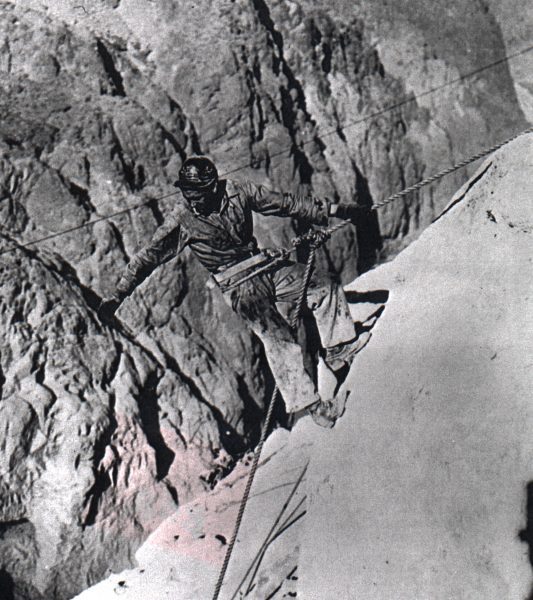 A high scaler working at Hoover Dam
A high scaler working at Hoover Dam
And these high scalers weren’t just workers, they were also a tourist attraction. People would drive to Hoover Dam to see them in action.
And the high scalers would put on a show! Their work was so exciting to watch that one government overseer named Burl Rutlidge got a little too close while taking a peek. He slipped and fell over the edge towards the canyon floor below. Luckily, Rutlidge was caught by one of the high scalers and saved from an almost certain death. (Listen to min 10:51 for the full story).
Has the Hoover Dam met the needs and interests for which it was built?
When Hoover Dam was finished on May 29th, 1935, it began supplying water to the seven states that had come together to make the project happen. And in the years that followed, the economic benefits of the dam could be seen right across the American west (take Las Vegas for example). But since then, over reliance on the river has become an issue, and the water that was promised is just not there anymore. A quick look at the rockface around Lake Mead shows a large white ring where the water level used to be.
 The ‘bathtub ring’ of Lake Mead clearly shows where the water level once stood.
The ‘bathtub ring’ of Lake Mead clearly shows where the water level once stood.
Listen to the latest episode of Sounds Like Infrastructure to find out what the future has in store for Hoover Dam, as well as the story that got the dam to where it is today.





There are no comments yet